
 |
The Audio Pages |
| Elliott Sound Products | Project 70 |
DoZ Headphone Amp -
A New Use For The Class-A
Power Amp
Rod Elliott (ESP)
Updated 14 Oct 2000
You really need to see the original article - Project 36 - to see all the design details for this project. The project presented here is simply a modification of the original design, with much lower power dissipation and adapted specifically as a headphone amplifier. The circuit is identical to the original Death of Zen amp, except for the output transistors.
Class-A is ideal for this application, since headphones are such an intimate way of listening. An amplifier for 'phones should be as clean and free from crossover distortion as possible, and must also be quiet. A background of hiss and hum does nothing to enhance the listening experience.
Headphone amps are somewhat misunderstood, but in reality there are few points that need to be made. Most 'phones are designed to be operated with a source resistance of 120 ohms, and damping factor (as applied to conventional loudspeakers) is largely irrelevant. The actual source impedance should have very little (if any) effect on the frequency response or dynamic behaviour, since there is no cavernous enclosure and no heavy cones to try to control.
The IEC 61938 international standard recommends that headphones should expect a 120 ohm source (5V RMS maximum) - regardless of the headphone's own impedance. If the manufacturer followed this standard, the 120 ohm resistor used in this circuit will not affect sound.
Power requirements are usually in the 10
to 100mW range, and this is quite sufficient to cause permanent hearing
damage. With the current set for 330 mA as suggested, this amp will
be able to drive a minimum of 2 (but probably 3) sets of headphones at
once. With 40 Ohm 'phones, it can give a maximum power of over 150
mW, so caution is needed to prevent hearing (and headphone) damage.
Even with 8 ohm 'phones, power will be about 110mW - more than enough to
have you asking people to repeat everything they say!
| Caution! Just in case you missed it, headphones are easily capable of causing permanent irreparable hearing damage. Modern dynamic headphones are very efficient (typically over 90dB SPL per milliwatt) and will reach full volume with just a few milliwatts of input. A mere 100 mW will therefore provide a peak SPL of around 110dB SPL. The recommended maximum exposure to this sound level is less than 1/2 hour in any 24 hour period ! |
Based on a maximum voltage of 10V RMS and
a feed resistance of 120 ohms, the following table shows what peak power
you should expect into various impedance headphones. Reducing the
feed resistance will increase the power applied, probably to the detriment
of your ears and the headphones themselves.
| Impedance (ohms)... | Power (mW)... |
| 8 | 48.83 |
| 16 | 86.51 |
| 32 | 138.50 |
| 40 | 156.25 |
| 65 | 189.92 |
| 100 | 206.61 |
You might need to adjust the value of the feed resistor(s) if you have really low sensitivity headphones, but unless it is absolutely necessary - don't !
The final circuit for the DoZ headphone amp is shown in Figure 1. It is almost identical to the original (well, apart from the output transistors and size of C3, it is identical), and there is no longer the need for massive heatsinks and TO-3 output transistors. As shown, there are outputs for 2 sets of headphones. Needless to say, only one channel is shown - the other is identical.
For final testing you will need a multimeter. As shown in the power supply circuit below, use a 10 Ohm resistor in series with the power supply positive lead. When you measure 1 volt across this resistor, this means that the amplifier is drawing 100 mA. The resistor remains in circuit, providing a useful reduction in supply ripple. You will lose about 3.3 V at operating current, and a 5W resistor is sufficient - it will get slightly warm. The output resistors (120 Ohm) should be rated at at least 2 Watts - a pair of 220 ohm 1W resistors in parallel will do just fine (the absolute value is not critical).
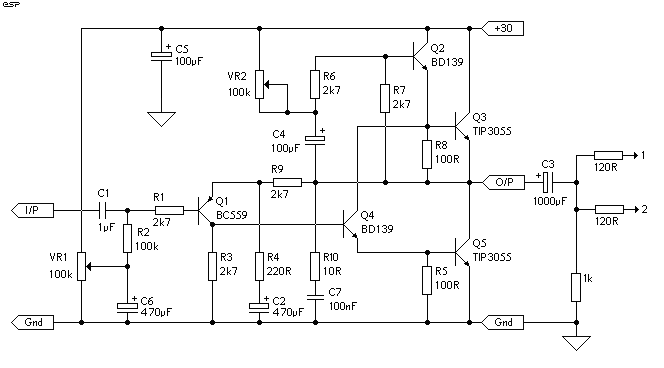
Figure 1 - DoZ Headphone
Amplifier
| Q3 and Q5 (the output transistors) must be on a heatsink (see below), and even for headphone use, Q2 and Q4 require a small heatsink. |
A quick circuit description is in order. VR1 is used to set the DC voltage at the +ve of C3 to 1/2 the supply voltage (20V for a 40V supply), by setting the voltage at the base of Q1. The 470uF cap ensures that no supply ripple gets into the input. Using such a large value also prevents any thump into the headphones as C3 (the output capacitor) charges. The voltage rise is so slow that no audible noise is heard as the amp is powered on. Q1 is the main amplifying device, and also sets the gain by the ratio of R9 and R4. As shown, gain is 13, or 22dB, providing an input sensitivity of about 1V for full output.
Q4 is the buffer for the output transistor Q5, and modulates the current in Q2 and Q3. VR2 is used to set quiescent current, which I found needs to be about 330 mA for best overall performance. C4 and R6 are part of a bootstrap circuit, which ensures that the voltage across R6 remains constant. If the voltage is constant, then so is the current, and this part of the circuit ensures linearity as the output approaches the +ve supply.
If the DoZ PCB is used, the output components (C3, the two 120 ohm 2W resistors, and the 1k resistor to earth) are mounted "off-board". The output resistors are best mounted directly to the headphone jack, and the remaining parts can be mounted anywhere convenient.
Before applying power, set VR1 to the middle of its travel, and VR2 to maximum resistance (minimum current). Be very careful - if you accidentally set VR2 to minimum resistance the amp will probably self destruct - more or less immediately.
With an ammeter in series with the power supply (or measure the voltage across the 10 Ohm power supply resistor), apply power, and carefully adjust VR2 until you have about 330mA. Set VR1 to get 15V at the +ve of C3, and re-check the current. As the amp warms up, the current may increase, and you need to monitor it until the heatsinks have reached a stable temperature. If necessary, re-adjust VR2 and VR1 once the amp has stabilised. If you use a heatsink smaller than about 2o C/W the amp will overheat and will be thermally unstable - this is not desirable (note use of extreme understatement :-)
I used a 30V (nominal) supply, and was able to obtain 150mW into typical 40 ohm headphones at the onset of clipping. Like the original, clipping is a lot smoother than most solid state amps, and the amp has no bad habits as it clips.
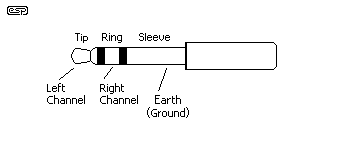
Figure 2 - Wiring of
a Headphone Plug
Figure 2 above shows how to wire a standard stereo headphone plug. The tip is the left channel, the ring is the right channel, and the sleeve is earth (ground). Use an ohmmeter or continuity tester to determine the channel designations of the solder lugs inside the jack plug body. With a headphone jack, insert a headphone plug with known wiring scheme and use an ohmmeter or continuity tester to match the jack connections to the plug. Use this scheme when wiring the socket(s) to ensure that Left and Right channels are not reversed. The proper connections are shown in Figure 3.
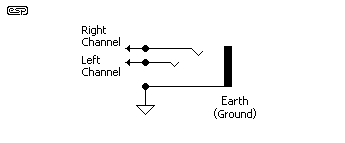
Figure 3 - Phone Jack
Wiring
On the basis of the tests, I would rate this amp at 150 mW into 40 Ohm headphones, although I did get a little more. Distortion probably rises with increasing level, but I have no way of knowing, as it is so low - even at 10V RMS output into a 50 ohm load the distortion was about the same as the residual of my oscillator, which means that it must be below 0.04%, but I have no idea just how low it gets.
I simply used components as I found them,
and did no matching or any selection. All test results are based
on the prototype, which uses ordinary resistors, a couple of old salvaged
computer caps for the high values, and standard electrolytics for the others.
The input capacitor is an MKT polyester type or you can use a standard
electrolytic if you want to (the positive goes to the junction of R1 and
R2).
| Supply Voltage | 30V | |
| Suggested Quiescent Current | 330 mA | |
| Maximum power (40 ohm 'phones) | 350 mW | |
| Output Noise (unweighted, 1k ohm source) | <1 mV | |
| Distortion @ 1kHz, 10V RMS at output | < 0.4% | |
| Output Impedance | 120 ohms | |
| Frequency Response (-0.5dB @ 100 mW) | <20Hz to >50kHz |
I could hear no noise at all, even with a very basic power supply. The output noise level I measured was about 0.5mV, but it is not easy to measure accurately at such low levels. There appeared to be no residual hum that I could see on the oscilloscope, even with averaging turned on.
The amp will also tolerate an indefinite short circuit across the headphone socket(s) with no ill effects, and even (blush) reverse polarity. I accidentally connected the supply up backwards while testing the original, and thought "Oh, no. Now I'll have to rebuild the blessed thing" (if the truth be known I thought something much shorter!). However, I connected the supply the right way 'round, and away it went, as if nothing had ever happened. This is not an experiment I suggest to others.
The design is also unaffected by quite a few component variations. When I first started testing the original DoZ amp, there were no emitter-base resistors in the current source, and when I added them, I simply readjusted the two pots to get everything back where it was. I retested distortion after making the changes, and could measure no difference.
I have also designed a simple, high performance
preamp circuit (all discrete Class-A), which is very nice indeed (see Project
37). The distortion is very low, and frequency response is excellent.
As the supply voltage changes with normal variations in AC mains voltage, the quiescent current also shifts. This is not desirable, and is easily solved with the addition of a resistor and a zener diode (or a series string for odd voltages). If you are using a regulated supply, this mod is not needed.
The process is very simple. First, measure the actual nominal supply voltage - the amp(s) must be connected. Subtract 5 to 7 volts from the measured voltage, to obtain a value that can be matched by standard zener diodes. For example, your supply voltage might be 38V, so a zener voltage between 31 and 33 volts is needed. Since 33V is a standard voltage, that will be fine.
The complete updated circuit is shown in Figure 5, and also shows the actual circuit used on the PCB (excluding the modification described here). The voltage for the quiescent current setting and output voltage is now reasonably well fixed, so mains voltage variations will have very little effect on the overall current of the output stage. Minor variations are also prevented from causing slow voltage shifts at the output. These were never audible, as the circuit is deliberately very slow, but eliminating them cannot be a bad thing.
For those who have purchased PCBs for this project, please e-mail me and I will explain the process to incorporate this mod on the board. It requires that one track be cut, and a resistor and zener (or zener string) attached to the underside of the board. Despite the sound of this, it is completely painless :-)
D1 and D2 are zener diodes - you may only
need one of them, depending on your supply voltage. The selection
process is described fully below. Within the useful range of zeners,
the following values are standard and suitable for the purpose ...
| 10V | 12V | 15V | 16V | 18V | 20V | 24V | 30V | 33V |
Values higher than 33V are uncommon in retail electronics outlets, and anything lower than 10V is not recommended in a series string for this application.
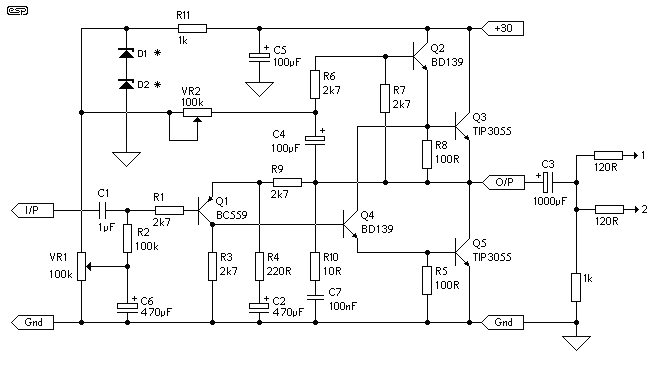
Figure 5 - The Complete
DoZ Headphone Amp (With Iq Stabilisation)
* These components are not provided for on the PCB without modification.
There are a few other small changes to the circuit, but these are simply to reflect the PCB design and are of no real consequence. A zobel network has been included - not because the amp needs it, but just in case a reactive load that may cause instability is connected. C5 has been reduced in value so it will fit on the board, and C3 (still very much needed !) is mounted off the board as it is too large for PCB mounting (it would almost double the board size).
A quick calculation example for the zener rating and resistance are in order, so it is properly understood. The maximum zener current for a given voltage is easily calculated ...
Iz = Pz / Vz where Iz is zener current, Pz is the power rating, and Vz is the zener voltageSmall zeners are typically rated at 400mW and 1W. A 33V 400mW zener therefore has a maximum current of 12mA. Allowing for a resistor voltage drop of 5 to 7 volts means that the zener current will be 5 to 7 mA (1V across 1k gives 1mA). Since it is recommended that zeners be operated at between 5% and 80% of the maximum rated current, this fits very nicely into our requirements.
Should you find that you need a zener voltage of (say) 36V, then two 18V zeners would be the most appropriate. Try to ensure that the zener current is at least 5% of the maximum, or the regulation will not be as good as it should be. This means that you will need to use a pair of higher voltage zeners in preference to one high voltage and one low voltage.
For example, 36V (near enough) can also be created with a 33V and a 3.3V zener in series. The 3.3V zener will have a maximum current of 120mA (assuming 400mW), and you will barely achieve the 5% minimum current needed (6mA in this case).
The modification described here does not change the measured performance of the amp, and creates no audible differences whatsoever. It is designed to stabilise the quiescent voltage and current, and it does that quite well. Some small variations will still be measured, but are so reduced in magnitude as to be considered negligible for all practical purposes.
As I have said before, this amp needs a fairly good heatsink, as do all Class-A amplifiers. Even 'though this amp runs at very low current, a good heatsink is recommended. Thermal resistance should ideally be no greater than about 2oC/W, so with a dissipation of about 10W the heatsink will be 20 degrees above ambient temperature. This is still quite hot, and a larger heatsink will not hurt one little bit :-)
If you can't keep your fingers on transistors, then they are hotter than I like to operate them - I know they will take much more, but it shortens their life. A small heatsink is also recommended for the drivers, as they get surprisingly warm without one.
A suitable supply for a pair of DoZ headphone
amps is shown below. I must firstly give this ...
| WARNING: Mains wiring must
be done using mains rated cable, which should be separated from all DC
and
signal wiring. All mains connections must be protected using heatshrink tubing to prevent accidental contact. Mains wiring must be performed by a qualified electrician - Do not attempt the power supply unless suitably qualified. Faulty or incorrect mains wiring may result in death or serious injury. |
A simple supply using a dual 25V secondary transformer will give a voltage of around 35V. Allowing for the voltage drop across the 10 ohm resistor, this will give a typical supply voltage of a little under 30V for each amplifier. The actual voltage is influenced by a great many things, such as the regulation of the transformer, amount of capacitance, etc. For a pair of amps, a 50VA transformer will be (just) sufficient. Feel free to increase the capacitance, but anything above 10,000uF brings the law of diminishing returns down upon you. The performance gain is simply not worth the extra investment.
The amp is quite tolerant of supply ripple, and a simple supply will almost certainly be fine. A suitable power supply is shown in Figure 4, or for the perfectionist, use the capacitance multiplier circuit (Project 15). There really is no need for anything more than the circuit shown below - supply ripple is less than 12mV RMS when loaded, and no hum was heard at all. The added advantage of the circuit shown is that it will self correct (to some degree) variations in quiescent current with supply voltage.
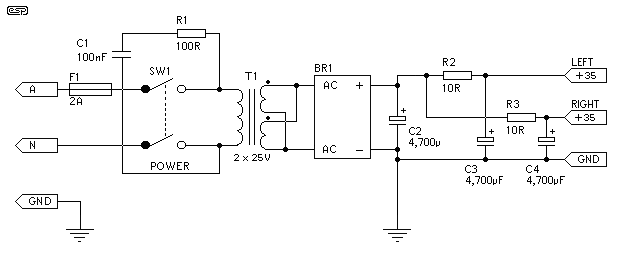
Figure 4 - Suitable Power
Supply
For the standard power supply, as noted
above I suggest a 50VA transformer as a minimum - 100VA is preferred.
For 115V countries, the fuse can remain as 2A, and a slow blow fuse is
required for toroids because of the inrush current of these transformers.
If using a conventional laminated transformer, then fast blow fuses should
be OK.
| Note that the secondary windings are in parallel, and the dots indicate the start of each winding. When windings are paralleled it is imperative that the phasing is correct, or the main fuse will blow. In some cases, the transformer may be damaged by the overload. |
C1 must be rated for 240V AC (or 120V AC) operation - do not use standard 250V DC caps under any circumstance, as they will fail, and R1 will explode! This is not intended as humour - this is fact! C1 and R1 may be omitted in most cases, and if you cannot get a mains rated capacitor I suggest that you don't install these components.
The supply voltage can be expected to be higher than that quoted at no load, and less at full load. This is entirely normal, and is due to the regulation of the transformer. In some cases, it will not be possible to obtain the rated power if the transformer is not adequately rated.
R2 and R3 should be 5W wirewound types, the bridge rectifier can be a 5A type if you want (35A bridges are cheap enough, and the latter are preferred), and filter capacitors should be rated at a minimum of 50V. Wiring needs to be heavy gauge, and the DC must be taken from the capacitors - never from the bridge rectifier.
As shown, a separate feed is used for each channel. I strongly recommend this approach to ensure that there is no low frequency interaction between the amps.
HeadWize
- Everything you ever wanted to know about headphones
Project 36
- Death of Zen Class-A Power Amplifier
| Copyright
Notice. This article, including but not limited to all text and diagrams,
is the intellectual property of Rod Elliott, and is Copyright |